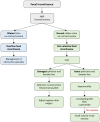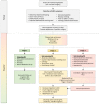State of the Art Bowel Management for Pediatric Colorectal Problems: Hirschsprung Disease
- PMID: 37628417
- PMCID: PMC10453740
- DOI: 10.3390/children10081418
State of the Art Bowel Management for Pediatric Colorectal Problems: Hirschsprung Disease
Abstract
After an initial pull-though, patients with Hirschsprung disease (HD) can present with obstructive symptoms, Hirschsprung-associated enterocolitis (HAEC), failure to thrive, or fecal soiling. This current review focuses on algorithms for evaluation and treatment in children with HD as a part of a manuscript series on updates in bowel management. In constipated patients, anatomic causes of obstruction should be excluded. Once anatomy is confirmed to be normal, laxatives, fiber, osmotic laxatives, or mechanical management can be utilized. Botulinum toxin injections are performed in all patients with HD before age five because of the nonrelaxing sphincters that they learn to overcome with increased age. Children with a patulous anus due to iatrogenic damage of the anal sphincters are offered sphincter reconstruction. Hypermotility is managed with antidiarrheals and small-volume enemas. Family education is crucial for the early detection of HAEC and for performing at-home rectal irrigations.
Keywords: Hirschsprung disease; botox; botulinum toxin; bowel management; constipation; enema; enterocolitis; fecal incontinence; irrigation; laxatives; obstruction; total colonic aganglionosis.
Conflict of interest statement
The authors declare no conflict of interest.
Figures







References
Publication types
LinkOut - more resources
Full Text Sources

